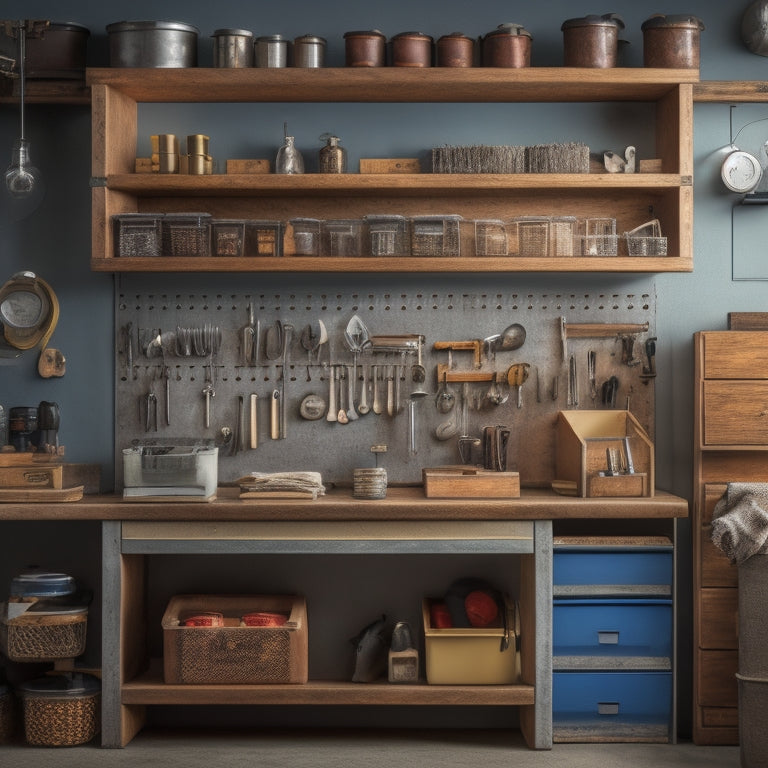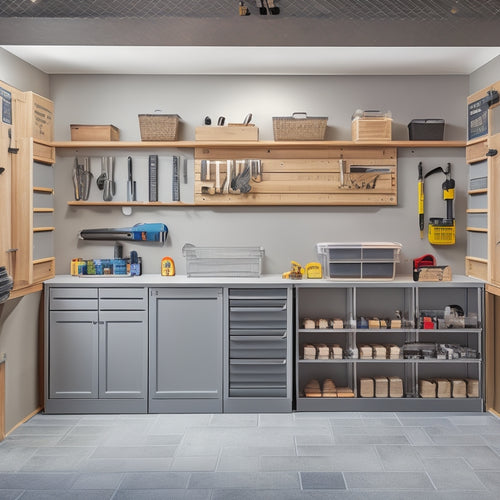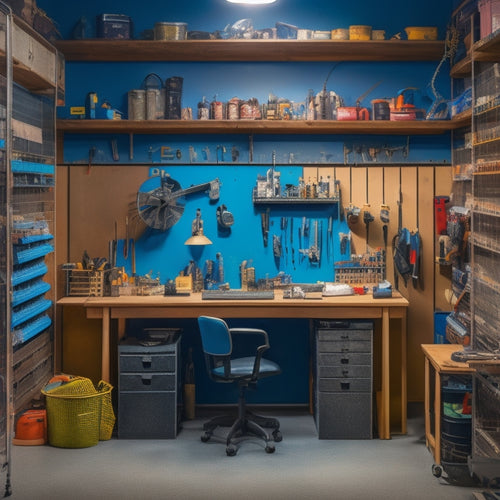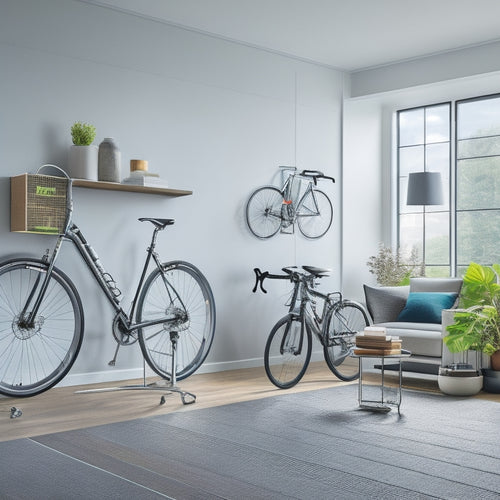
Streamline Your Workspace: Key and Tool Storage Solutions
Share
You're tired of wasting time searching for misplaced keys and tools. To streamline your workspace, start by choosing the right key holder for your needs. Consider the number of keys and the level of smart key storage you require. Next, maximize your vertical storage space with wall-mounted shelves, hooks, and bins. Organize small tools into categories and assign a designated space for each group. Customizing a tool pegboard and creating clear labels will also help you stay organized. By implementing these solutions, you'll be able to focus on what matters - and discover even more ways to optimize your workspace for peak productivity.
Key Takeaways
• Choose a key holder that fits your key collection size and workflow needs, considering smart storage features and decorative options.
• Maximize vertical storage space with wall-mounted shelves, hooks, and bins designed for specific items, keeping your workspace organized and clutter-free.
• Organize small tools efficiently by categorizing, assigning spaces, and using storage solutions like drawer dividers, wall hooks, and magnetic strips.
• Customize your tool pegboard by grouping similar tools, color-coding, and placing frequently used tools in easy-to-reach locations.
• Use clear and consistent labeling, signage, and color-coding to easily identify and navigate your tools and keys, saving time and reducing frustration.
Choosing the Right Key Holder
When selecting a key holder, you'll want to factor in the number of keys you need to store, as this will dictate the type of holder that best suits your needs. If you have a small collection of keys, a decorative key holder or a minimalist key hook may be the perfect solution. These options aren't only functional but also add a touch of style to your workspace.
On the other hand, if you have a large number of keys, you'll want to take into account a wall-mounted key rack that can hold multiple keys. This will keep your keys organized and within easy reach.
Another important thing to keep in mind is the level of smart key storage you need. Do you want a key holder with individual hooks or a compartmentalized design? Think about how you'll be using your keys and choose a holder that fits your workflow.
Maximizing Vertical Storage Space
By strategically utilizing wall-mounted storage solutions, you can effectively maximize your vertical space, keeping your keys, tools, and other essential items within easy reach while freeing up valuable floor and surface area. This is especially important in small workspaces where every inch counts.
To make the most of your vertical storage, consider installing shelves, hooks, or bins specifically designed for the items you need to store. For example, you can use a pegboard with hooks for hanging tools, or a slatwall with bins for storing small parts and accessories.
When selecting wall-mounted storage solutions, look for products that are adjustable, durable, and easy to install. Consider the weight capacity and size of the items you need to store, and choose solutions that can accommodate them.
By maximizing your vertical storage space, you'll be able to keep your workspace organized, clutter-free, and efficient. This, in turn, will help you stay focused and productive, allowing you to better serve your clients and customers.
With the right vertical storage ideas and space-saving solutions, you can create a more functional and efficient workspace that supports your goals and priorities.
Organizing Small Tools Efficiently
How do you currently store your small tools, and are they easily accessible when you need them? If you're like many, they're probably scattered throughout your workspace, wasting valuable time and energy searching for them.
It's time to get organized! Start by categorizing your small tools into groups, such as pliers, screwdrivers, and wrenches. Then, assign a designated space for each group. Drawer dividers can help keep your tools from getting jumbled together, while wall hooks can hang frequently used items like hammers and levels.
Magnetic strips are perfect for storing small metal tools like drill bits and sockets. For smaller items like nuts and bolts, consider using hanging baskets or small containers.
Customizing Your Tool Pegboard
You've got your small tools organized, now it's time to take your storage to the next level by customizing your tool pegboard, where you can hang items like wrenches, pliers, and screwdrivers in a way that makes sense for your workflow. Start by grouping similar tools together, such as all your pliers or screwdrivers, to create a logical tool arrangement.
Consider color coding your tools to further categorize them, using different colored hooks or bins to separate tools by type or frequency of use. This will make it easy to identify the tool you need at a glance.
Next, think about the frequency of use for each tool. Place your most frequently used tools in easy-to-reach locations, and reserve higher or lower hooks for less often used items. Don't forget to leave some space between tools to prevent overcrowding and make it easy to add or remove tools as needed.
Labeling and Signage Best Practices
When setting up your key and tool storage system, you'll want to prioritize labeling and signage to guarantee easy identification and access.
By following best practices, you'll be able to create a system that's intuitive and efficient, saving you time and frustration in the long run.
In this section, you'll learn how to:
- Create clear and consistent labels
- Optimize visibility and readability
- Establish a signage hierarchy that makes sense for your specific needs.
Clear and Consistent Labels
Implementing a labeling system with clear and consistent labels is essential to ensuring that tools and keys are easily identifiable and quickly accessible. You'll save time and reduce frustration when you can quickly locate the tool or key you need. Consistent labeling also helps prevent mistakes, as you'll be less likely to grab the wrong tool or key.
When creating labels, consider the following best practices:
| Best Practice | Description |
| Use a standard font | Choose a font that's easy to read and use it consistently throughout your labeling system. |
| Keep labels concise | Use short descriptions that clearly identify the tool or key. |
| Use color-coding | Use different colors to categorize tools or keys, making them easier to find. |
Visibility and Readability Matters
To ensure your labels and signs are effective, make them highly visible and readable by choosing the appropriate size, material, and placement. Consider the distance at which you'll be viewing them and select a font size and style that's simple to read. You'll also want to choose a material that can withstand the environment of your workspace, such as waterproof or scratch-resistant options.
Implement color-coding strategies to categorize your labels and signs, making it easier to quickly identify what you need. This is especially helpful when you have multiple items or categories to keep track of. Additionally, incorporate ergonomic design principles to optimize your labels and signs are placed at a comfortable viewing height, reducing eye strain and improving productivity.
Don't forget to declutter your workspace to reduce visual noise and make your labels and signs stand out. The ideal lighting is also essential, so consider installing LED lighting or repositioning your labels and signs to take advantage of natural light.
Signage Hierarchy Essentials
You'll need a clear signage hierarchy to guide your team through the workspace, directing them to specific areas or bins containing the tools and keys they need. A well-organized signage system guarantees that your team can quickly find what they're looking for, saving time and increasing productivity.
To create an effective signage hierarchy, start by using color coding to categorize different types of tools or keys. This visual cue will help your team quickly identify the section they need.
Next, consider spatial planning, placing signs in areas where they're easily visible and accessible. When designing your signs, prioritize font size and visual hierarchy. Use large, bold fonts for main categories and smaller fonts for subcategories. This will create a clear visual flow, making it easy for your team to navigate the workspace.
Keeping Frequently Used Items Accessible
By designating a prime location for your most frequently used keys and tools, you can shave valuable minutes off your daily routine and boost overall productivity. This is especially true when it comes to desk organization, where tool accessibility is essential.
By keeping your most-used items within easy reach, you'll reduce the time spent searching for them, allowing you to focus on serving others more effectively.
To achieve peak workspace efficiency, consider implementing a 'golden zone' on your desk or workspace. This zone should be reserved for your most frequently used items, such as keys, screwdrivers, or pliers. By doing so, you'll maintain clutter control and optimize that your workspace remains tidy and organized.
Additionally, label each item's designated spot to guarantee that everything has a home, making it easier to find what you need quickly. By streamlining your workspace in this manner, you'll be able to provide better service to others, as you'll be able to respond more promptly and effectively to their needs.
Managing Cords and Cables Effectively
As you organize your workspace to optimize accessibility, it's equally important to tackle the tangled web of cords and cables that can quickly clutter your area.
Effective cable management is pivotal to maintaining a decluttered and efficient workspace. Start by identifying the cords and cables that need to be organized, and then group them by category, such as power cords, data cables, and audio cables.
Use cord organizers, cable ties, or zip ties to keep them tidy and prevent tangles. Label each cord or cable so you can easily identify what it's connected to. This will save you time and reduce frustration when you need to troubleshoot or replace a device.
By implementing these cord organization techniques, you'll be able to focus on serving others without the distraction of a cluttered workspace.
A well-organized workspace not only boosts your productivity but also enhances your overall work experience. By streamlining your cord management, you'll be able to provide better service to those you're serving.
Utilizing Hidden Storage Compartments
Take advantage of often-overlooked spaces in your workspace by incorporating hidden storage compartments that keep your tools and supplies out of sight yet easily accessible. These creative solutions will help you optimize your space, making the most of every nook and cranny.
Consider installing hidden drawers or shelves in your desk or cabinets to store frequently used items like pens, paper clips, or screwdrivers. You can also utilize the space under your work surface by attaching a slide-out tray or a pedestal with built-in storage. Clever designs like these will help you stay organized and focused, allowing you to serve others more efficiently.
Additionally, think about repurposing old furniture or containers to create unique hidden compartments. For example, convert an old file cabinet into a storage unit for your tools or use a decorative box to store small supplies. By incorporating these hidden storage compartments, you'll be able to maintain a clutter-free workspace, freeing up time and energy to focus on what matters most – serving others.
Creating a Functional Workflow Station
Designate a specific area of your workspace as a functional workflow station, where you can efficiently sort, categorize, and prioritize tasks, tools, and supplies, streamlining your entire workflow process. This dedicated space should be tailored to your specific needs, incorporating an ergonomic desk setup that promotes comfort and reduces fatigue.
Implement effective file management systems, such as labeled folders and digital storage, to keep important documents within easy reach.
To maintain a clutter-free workspace, establish efficient workflow systems that enable you to quickly access the tools and supplies you need. Consider investing in a tool organizer or storage bins to keep frequently used items tidy and organized.
Frequently Asked Questions
Can I Use a Pegboard in a Small Workspace or Closet?
You can definitely use a pegboard in a small workspace or closet by choosing a compact size, utilizing wall space, and selecting hooks and bins that fit your needs, maximizing closet organization and small space solutions.
How Do I Prevent Tool Corrosion in Humid Storage Environments?
You'll prevent tool corrosion in humid storage environments by applying rust prevention techniques, such as silicone-based sprays or wax coatings, and using moisture-resistant tool coatings, like ceramic or epoxy-based finishes, to shield your tools.
Are There Key Holders With Built-In USB Charging Stations?
You'll find key holders with built-in USB charging stations that offer wireless charging options, and some even feature hidden compartment designs, keeping your keys and devices organized and charged on the go.
Can I Customize Storage Solutions for Left-Handed Users?
When accommodating unique needs, you'll find that many manufacturers cater to left-handed individuals, offering customized solutions that prioritize left-handed organization, ensuring a seamless workflow that boosts efficiency and productivity.
Are There Any Eco-Friendly Key and Tool Storage Options Available?
You'll find eco-friendly key and tool storage options that align with your values, using sustainable materials like recycled plastic, bamboo, or FSC-certified wood, reducing waste and minimizing environmental impact.
Related Posts
-

Essential Steps for Garage Storage System Design
You're about to change your cluttered garage into an organized haven by following a structured approach to garage sto...
-

3 Key Steps to Streamline Your Workshop Organization
You're likely wasting 30% of your workshop's productivity and profitability due to disorganization, a common problem ...
-

Must-Try Bike Storage Ideas in Small Spaces
You're tired of sacrificing precious living space to store your bike, especially in small homes where every square fo...


